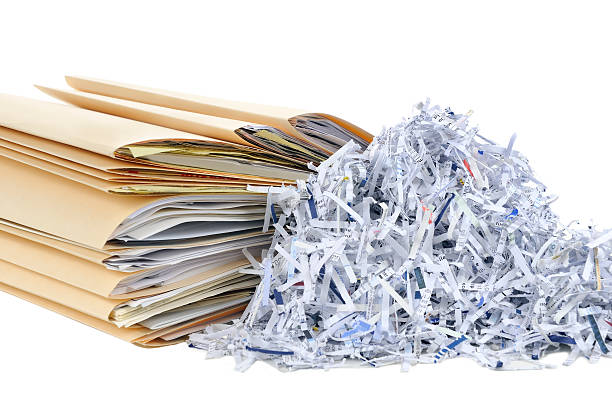Welcome to the world of paper shredding in which turning files into confetti isn’t just about tidying up, but about safeguarding your secrets. In an age in which statistics breaches loom big and identity theft is a real challenge, the safety of shredded paper is more vital than ever.
But how impervious is it? Can the tiny bits of paper be pieced and returned together like a puzzle via crafty hackers? And what’s the safest thanks to shredding sensitive files at domestic or in the office?
Join us as we delve into the intricacies of paper shredding safety, exploring the effectiveness of cross-reduce as opposed to strip-reduce shredders, the risks of DIY shredding, and the way frequently groups have to shred to live one step in advance of capacity threats.
Get equipped to shred your concerns and find out simply how invulnerable shredding paper may be in these days’s virtual age.
Can Shredded Paper Be Reconstructed By Hackers?
Shredded paper may be a project for hackers to reconstruct due to the thoroughness of current shredding strategies. Fantastic shredders, mainly those employing cross-cut or micro-cut methods, transform documents into tiny, confetti-like pieces that are nearly impossible to reassemble. Even strip-cut shredders, which slice paper into long strips, present significant hurdles for reconstruction.
While dedicated hackers might try to reconstruct using specialized techniques, the effort required is massive and often impractical. Offering free shredding events near me 2024 can provide society with secure removal choices, making shredded paper a reliable process for saving exposed data from unauthorized access and probable identity theft.
What Are The Safest Methods For Shredding Confidential Paperwork?
The safest methods for shredding personal paperwork are using cross-cut or micro-cut shredders. These machines turn documents into tiny, unreadable pieces, much more secure than strip-cut shredders.
Cross-cut shredders shred paper into confetti-like particles, while micro-cut shredders reduce it to minuscule fragments resembling dust. Both methods significantly reduce the risk of sensitive data being reconstructed.
Ensure your shredder can handle staples and paper clips to avoid jams. Regular maintenance, such as blade oiling, enhances performance and durability. By adopting these methods, you can effectively protect personal information from prying eyes and potential identity theft. Look for free paper shredding events near me 2024 to find community opportunities for secure document disposal.
Is Cross-Cut Shredding More Secure Than Strip-Cut Shredding?
Certain, move-lessen shredding is normally extra secure than strip-lessen shredding. go-lessen shredders slice files horizontally and vertically, creating confetti-like portions that are probably harder to reassemble than prolonged strips from strip-reduced shredders.
The smaller particles created via way of circulate-reduce shredders make it plenty more difficult for someone to retrieve sensitive data, thereby enhancing safety. This approach is often encouraged for eliminating private archives, providing a higher degree of protection against identification robbery and ensuring that shredded materials stay irretrievable.
Are There Risks Involved In Using Personal Shredders At Home?
the usage of personal shredders at home comes with some dangers to consider. Overloading the shredder can cause jams, and frustrating tries to clear them like a Rubik’s cube besides a guide.
Moreover, the blades need everyday oiling to maintain performance, corresponding to being concerned for a cranky lawnmower. there’s also the chance of unintended harm if arms wander too close to the ones’ voracious blades.
regardless of those risks, with the right care and attention to shredding ability and protection, non-public shredders remain powerful equipment for maintaining privacy and tidiness at home. just be aware, that a chunk of warning can preserve both files and digits intact.
How Often Should Businesses Shred Documents To Maintain Security?

The golden rule of file shredding for organizations: shred frequently and shred smartly. whilst precise frequencies range depending on your industry and neighbourhood policies, an excellent rule of thumb is to shred documents as quickly as they’re no longer wanted for day-by-day operations or legal requirements.
This continues sensitive information from piling up like a virtual hoarder’s nightmare. So, whether you shred weekly, month-to-month, or on-call, maintain it steady and live one step ahead of facts breaches.
What Should I Look For In A Shredding Service To Ensure Security?
Look for certifications like NAID, secure chain-of-custody processes, and reputable reviews. Ensure they offer on-site or off-site shredding options tailored to your needs.
How Does Shredding Protect Against Identity Theft?
Shredding ensures personal information is irreversibly destroyed, preventing thieves from piecing together sensitive details like account numbers or addresses to steal identities.
Can Shredded Documents Be Recycled Securely?
yes, the shredded paper may be recycled securely while treated through reliance on recycling applications or centres that control confidentiality via secure disposal and recycling practices.
Choosing to shred personal office work the usage of move-cut or micro-reduce shredders is indispensable for ensuring maximum protection. these strategies remodel files into unreadable fragments, notably lowering the danger of sensitive records falling into the incorrect fingers. regular maintenance and the right use of shredders further enhance their effectiveness in protecting privacy.
through adopting these practices, individuals and businesses can optimistically guard their statistics, mitigating the threat of identity robbery and keeping compliance with facts and safety regulations. Shredding no longer solely protects privacy however also promotes accountable waste management by facilitating the recycling of shredded paper, contributing to environmental sustainability.
Here are some other articles related to your search:





